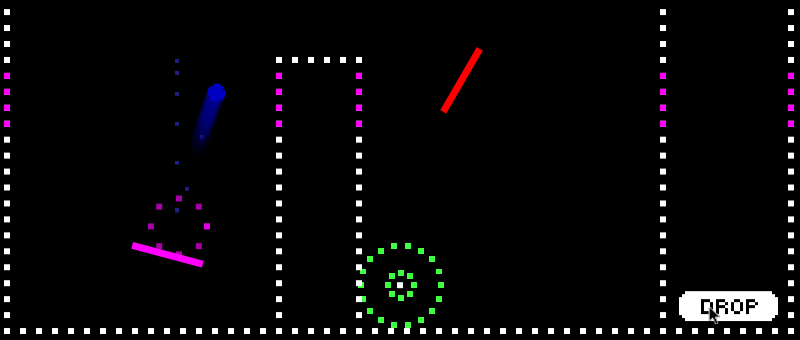Kinetics is another addition to the escalating pile of so-called physics puzzlers where you must position trampolines and the like to guide a particularly bouncy blue ball from its starting position, through optionally collectible-for-points coins, to a portal. For what reason, I’m not quite sure; it’s probably just for a bit of fun.
On completion of a level, you’re awarded with points based on performance; for example, how many attempts a puzzle took to solve. While these rewards encourage swift and precise thinking, the points don’t seem to have much depth or effect. With over forty levels and a noticeable difficulty curve, there’s quite a bit to munch at (as you’d expect for a game with almost a year of development time). As you progress through the levels, new mechanisms are introduced to offer fresh means of manipulating the ball’s path, and more obstacles will appear to amplify the challenge. As these are introduced brief explanations are given and if you ever get confused, you can refer to the instructions found on the main menu.
Whether you get very far in the game is questionable; unlike The Machine, you must complete the levels sequentially, which means that if you get stuck, you’re going to become slightly frustrated. The game does quite a respectable job at preventing this, though; the line the ball took on your last attempt is shown (even if this does promote the horrors of trial and error) and, bar the convoluted graphical effects, tweaking and retrying is a relatively quick process. The authors of the game claim Kinetics has ‘unique gameplay’. Now, we all know that’s not entirely true but the gameplay is generally solid; the ball bounces off trampolines as you’d expect and the level design is acceptably varied while encouraging new approaches to solving different puzzles. Once you pass the first ten or so levels, you’ll start scratching your head (or just experimenting), but the puzzles never seem unreasonably tough. The controls are mostly intuitive, with a wheel scroll changing the angle of the items you place and a drag-and-drop system that means you’ll only ever need a hand firmly on your mouse. As for laptop mousepad users, that might be a problem.

It’s a simple but largely consistent affair from a graphical point of view, with differently coloured squares and a matching typeface dominating what you see on-screen. The level start/end effects are neat but, overall, the visuals seem to take the crude middle ground between retro and simplistic. As I mentioned before, the effects seem a little convoluted in a game where you’re going to need to restart and retry over and over again. Since I feel obliged to tell you what the game sounds like, I’ll inform you that it has nice synth beat music and simple sound effects.
If you dislike puzzlers that are a tad too dependent on physics, you might want to give Kinetics a miss. For everyone else, here’s a game full of tricky (arcadey) puzzles with some decent presentation to boot.


The coloured square effect/animations quickly get boring as they delay the game so much.